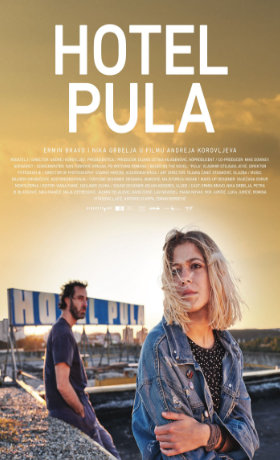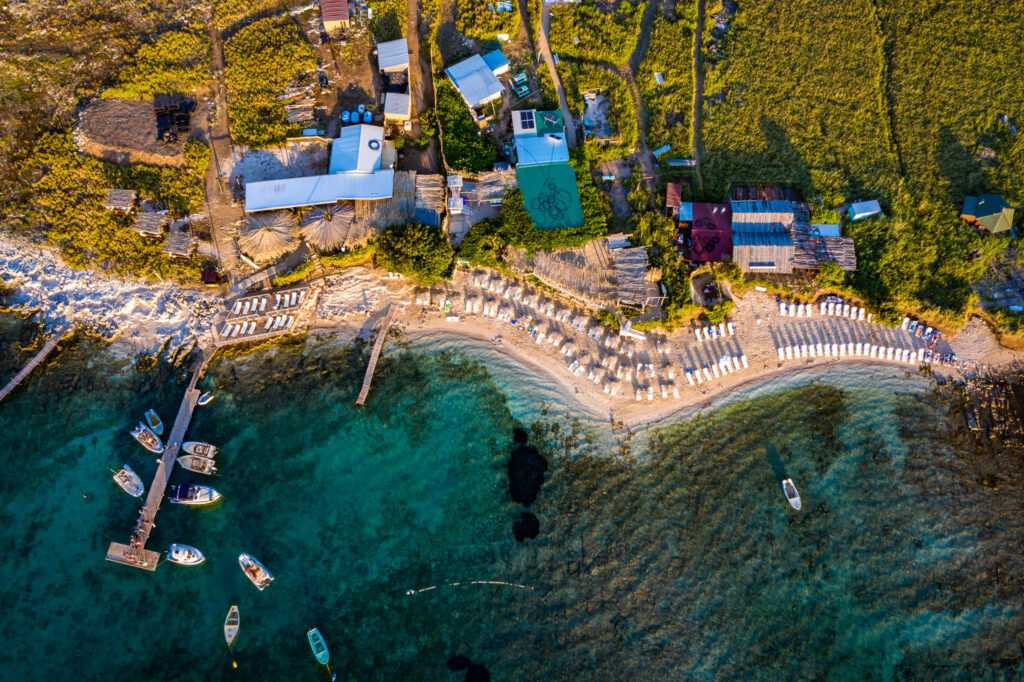
Synopsis
“Hotel Pula”, directed by Andrej Korovljev, was made based on the novel by Vladimir Stojsavljević. Set in a legendary Pula hotel, which is also famous for a disco from the glory days of punk music, it brings the story of a war refugee who is trying to find his way among new people and memories in post-war Istria. The story revolves around a quiet and gentle love story of two wounded people who find each other in a time of uncertainty. The film gathers a number of famous Croatian actors, as well as numerous extras from Pula. It was shown at numerous international film festivals and received multiple awards.
details
Original title: Hotel Pula
Year: 2023
Country of production: Croatia
Production: Kinematograf
Genre: drama
Directed by: Andrej Korovljev
Starring: Nika Grbelja, Ermin Bravo, Antonio Scarpa, Nika Ivančić, Lav Novosel, Petra Blašković
Filming locations in Istria: Pula
REVIEW
HOTEL PULA, directed by Andrej Korovljev, 2023
A REFUGEE AND A GIRL REBEL IN PULA WITHOUT A POSTCARD
“Hotel Pula”, directed by Andrej Korovljev, opened the 70th Pula Film Festival in 2023. The story revolves around the hotel Pula, placed above Gortan Cove, as a symbol of two clashing worlds from the turbulent 1990s: the hotel basement was an alternative punk scene, and the rooms were temporarily occupied by war refugees.
Mahir, a refugee from Bosnia, lives desolately, silently carrying war trauma which he doesn’t share with anyone. A local teenage girl, Una, finds her place under the Sun at parties and concerts in the hotel basement, escaping from a dysfunctional and chaotic home, with an alcoholic mother and a father who disappeared in Italy. Mahir’s depressive monotony is interrupted when he sees the girl from the hotel balcony, and then again when he unexpectedly meets Una. From worlds apart, which struggle to understand each other, the two begin a relationship which is more than just attraction: for Mahir, it is an attempt to return to his youth, and for Una, it is a way of finding freedom and rebellion. But, social, cultural and emotional differences are stronger than their mutual attraction. Mahir is haunted by the past in the form of Vahida, while Una is trying to comprehend something that goes beyond her youth.
In his directing feature début, Korovljev, a chronicler of a hidden, suppressed and marginalized face of Pula and its inhabitants, stays faithful to the documentaristic sensibility with a clear author line. Together with the director of photography, Stanko Herceg, he maps the authentic and recognizable parts of Pula which aren’t furbished for tourist postcards, achieving realistic atmospheres and contrasts, the image of Pula as it actually is, and especially as it used to be. With a few minor, almost imperceptible to those who are not familiar with the details of Pula, anachronisms in the picture, he skilfully “rewinds” time to that era, thus building the story on the atmosphere and layers of Pula, which is at the same time the backdrop and destiny as well as an extremely important, omnipresent character in this dramatic plot.
“Hotel Pula” was partly based on the novel “Pula” by Vladimir Stojsavljević Vaki (screnpay was written by Ivan Turković Krnjak), about the love story between a high school girl and a much older refugee from Bosnia. A broader portrait of 1990s Pula was built around that love story, depicting it as a city where refugees are welcome, but not necessarily fully accepted. Local patriotism, even without the aggressive nationalism, can take exclusive forms, which is something that Mahir directly experiences when trying to find a job and a place in new surroundings.
In this regard, we can quote the director himself: “Yes, we were tolerant, but that is far from enough; we should have shared our lives with theirs”, adding the importance of Una’s reactions at the birthday party, telling us that this is how new generations should be raised and taught. The mere plausibility of tolerance without real action is not enough, and is often counter-productive. The excellent construction of Una’s character, leaning on Mahir’s character, builds a dramatic plot, and in the context of the person Una represents Pula, but she is still psychologically immature for what Pula “as a person” could provide to a traumatized, suffering man whose life is an agonizing anticipation of death, who saw the light through her.
Here, we will reflect on the love story between Mahir and Una, which is actually a dramatic tension between two protagonists. Although played honestly and boldly, their relationship remains somewhat flat and relies on clichés: a young rebel girl falls for a silent, traumatized mystic with rural background. Of course, the lack of depth in their relationship is a result of both Una’s immaturity and Mahir’s drive to rise above his drabness, but with deeper characterization of these recognizable personalities, the film could have been emotionally stronger, and their story much more moving and profound.
Considering the artistic decisions, the directorial procedures, including the scene sequence, are extremely connected, in fact, they are united with space and time and in certain situations could be unclear to viewers who are not familiar with the iconic Pula locations where the film was shot. This is probably a part of discrepancy between the written novel and the cinematic nature of the screenplay, especially for viewers who don’t know the story at its core and who don’t feel it through memories.
Many operational ellipses become stylistic here and represent a distinctive language of the film, as if part of the plot was omitted by artistic decision, not so much in the editing process of framing the scene itself, but when connecting scenes to achieve the internal logic of the narrative. This may be confusing for viewers who didn’t experience the events from the film or who haven’t read the book. But, in spite of all that, “Hotel Pula” is an extremely important contribution to the regional cinematography, but also a powerful film about space, identity and gaps caused by the war, a film about the events, states and time which are still alive among many people in Pula and its surroundings.









